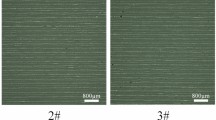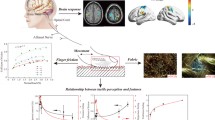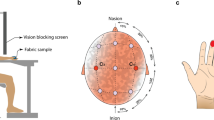Abstract
Sweats within the fabric–skin interface increase friction, cause stickiness perception, and facilitate wearing discomfort. To study the stickiness perception of wet fabrics, subjective assessment, skin friction, and neurophysiological response of the brain were systematically studied. Four fabrics that are commonly used as summer clothing were chosen for the tactile stimulus samples. Different wetness levels were designed by changing the sweat absorption amount. The results showed that the adhesive friction played a dominant role when the skin contacted the dry fabrics. The features of the friction coefficient μ, multiple fractal spectrum width, and P300 amplitude had strong correlations with the perceived stickiness of fabrics. Under dry and moist conditions, the surface roughness and water absorption capacity of fabric were the dominant factors that influenced the friction, vibration, and stickiness perception of fabrics. The parietal lobe and occipital lobe were positively activated and involved in the stickiness perceptions of fabric. Fabrics with low water absorption capacity and high μ tended to excite a high P300 amplitude and large activated brain area. The mechanical stimulation of the tactile receptor is associated with the brain’s cognition during stickiness perception. This study is meaningful for understanding the frictional behavior between fabric and skin surface and the cognitive mechanism in the stickiness perception of fabrics to reduce friction and improve wear comfort. It is also helpful in the evaluation of tactile stimulation of fabrics.









Similar content being viewed by others
Data Availability
Data are available on request.
References
Jiang, R., Wang, Y.: Research progress of stickiness perception of human body in dressing. J Text. Res. 40, 177–184 (2019). https://doi.org/10.13475/j.fzxb.20180702008
Lou, L., Ji, F., Qiu, Y.: Simulating adhesion of wet fabrics to water: Surface tension-based theoretical model and experimental verification. Text. Res. J. 85, 1987–1998 (2015). https://doi.org/10.1177/0040517515580531
Gerhardt, L.C., Strässle, V., Lenz, A., Spencer, N.D., Derler, S.: Influence of epidermal hydration on the friction of human skin against textiles. J. R. Soc. Interface. 5, 1317–1328 (2008). https://doi.org/10.1098/rsif.2008.0034
Maggie, K.P., Chau, K.H., Kan, C.W., Fan, Jtu: Magnitude estimation approach for assessing stickiness sensation perceived in wet fabrics. Fibers Polym. 19, 2418–2430 (2018). https://doi.org/10.1007/s12221-018-8626-9
Johnson, K.: Neural mechanisms of tactual form and texture perception. Annu. Rev. Neurosci. 15, 227–250 (1992). https://doi.org/10.1146/annurev.neuro.15.1.227
Bodegård, A., Ledberg, A., Geyer, S., Naito, E., Zilles, K., Roland, P.E.: Object shape differences reflected by somatosensory cortical activation. J. Neurosci. 20, RC51 (2000). https://doi.org/10.1523/jneurosci.20-01-j0004.2000
Amaied, E., Vargiolu, R., Bergheau, J.M., Zahouani, H.: Aging effect on tactile perception: Experimental and modelling studies. Wear 332–333, 715–724 (2015). https://doi.org/10.1016/j.wear.2015.02.030
Renganathan, P., Schwartz, C.J.: Investigation of human perception of tactile graphics and its dependence on fundamental friction mechanisms. Wear. 476, 203729 (2021). https://doi.org/10.1016/j.wear.2021.203729
Derler, S., Gerhardt, L.C.: Tribology of skin: Review and analysis of experimental results for the friction coefficient of human skin. Tribol. Lett. 45, 1–27 (2012). https://doi.org/10.1007/s11249-011-9854-y
Tomlinson, S.E., Lewis, R., Liu, X., Texier, C., Carré, M.J.: Understanding the friction mechanisms between the human finger and flat contacting surfaces in moist conditions. Tribol. Lett. 41, 283–294 (2011). https://doi.org/10.1007/s11249-010-9709-y
Jiang, R., Wang, Y.: Study of the human stickiness perception of wet fabric on the volar forearm via two contact modes: friction and adhesion-separation. Perception 49, 1311–1332 (2020). https://doi.org/10.1177/0301006620976992
Zhang, Z., Tang, X., Li, J., Yang, W.: The effect of dynamic friction with wet fabrics on skin wetness perception. Int. J. Occup. Saf. Ergon. 26, 370–383 (2020). https://doi.org/10.1080/10803548.2018.1453023
Moungou, A., Thonnard, J.L., Mouraux, A.: EEG frequency tagging to explore the cortical activity related to the tactile exploration of natural textures. Sci. Rep. (2016). https://doi.org/10.1038/srep20738
Muñoz, F., Reales, J.M., Sebastián, M.Á., Ballesteros, S.: An electrophysiological study of haptic roughness: Effects of levels of texture and stimulus uncertainty in the P300. Brain Res. 1562, 59–68 (2014). https://doi.org/10.1016/j.brainres.2014.03.013
Tang, W., Zhang, M., Chen, G., Liu, R., Peng, Y., Chen, S., Shi, Y., Hu, C., Bai, S.: Investigation of tactile perception evoked by ridged texture using ERP and non-linear methods. Front. Neurosci. (2021). https://doi.org/10.3389/fnins.2021.676837
Inui, K., Wang, X., Tamura, Y., Kaneoke, Y., Kakigi, R.: Serial processing in the human somatosensory system. Cereb Cortex. 14, 851–857 (2004). https://doi.org/10.1093/cercor/bhh043
Adhikari, B.M., Sathian, K., Epstein, C.M., Lamichhane, B., Dhamala, M.: Oscillatory activity in neocortical networks during tactile discrimination near the limit of spatial acuity. Neuroimage 91, 300–310 (2014). https://doi.org/10.1016/j.neuroimage.2014.01.007
Chen, S., Ge, S.: Experimental research on the tactile perception from fingertip skin friction. Wear 376–377, 305–314 (2017). https://doi.org/10.1016/j.wear.2016.11.014
Tang, W., Lu, X., Chen, S., Ge, S., **g, X., Wang, X., Liu, R., Zhu, H.: Tactile perception of skin: research on late positive component of event-related potentials evoked by friction. J. Text. Inst. 111, 623–629 (2020). https://doi.org/10.1080/00405000.2019.1661067
Camillieri, B., Bueno, M.A., Fabre, M., Juan, B., Lemaire-Semail, B., Mouchnino, L.: From finger friction and induced vibrations to brain activation: Tactile comparison between real and virtual textile fabrics. Tribol. Int. 126, 283–296 (2018). https://doi.org/10.1016/j.triboint.2018.05.031
Tang, K.P.M., Kan, C.W., Fan, J.T.: Psychophysical measurement of wet and clingy sensation of fabrics by the volar forearm test. J. Sens. Stud. 30, 329–347 (2015). https://doi.org/10.1111/joss.12161
Raccuglia, M., Hodder, S., Havenith, G.: Human wetness perception in relation to textile water absorption parameters under static skin contact. Text. Res. J. 87, 2449–2463 (2017). https://doi.org/10.1177/0040517516671127
Gottlieb, J.: From thought to action: The parietal cortex as a bridge between perception, action, and cognition. Neuron 53, 9–16 (2007). https://doi.org/10.1016/j.neuron.2006.12.009
Chen, Y.S., Chen, H.L., Lu, C.H., Chen, M.H., Chou, K.H., Tsai, N.W., Yu, C.C., Chiang, P.L., Lin, W.C.: Reduced lateral occipital gray matter volume is associated with physical frailty and cognitive impairment in Parkinson’s disease. Eur. Radiol. 29, 2659–2668 (2019). https://doi.org/10.1007/s00330-018-5855-7
Teodorescu, M., Rahnejat, H.: Nano-scale contact model for microfiber tip attachment, detachment and friction. 2008 Proc STLE/ASME Int J Tribol Conf IJTC 2008, 83–85 (2009). https://doi.org/10.1115/ijtc2008-71220
Li, C., Zhang, T., Zang, X., Zhao, Z., Fang, L., Zhao, N.: Void fraction measurement based on flow noise decoupling and differential pressure. IEEE Trans. Instrum. Meas. 71, 1–12 (2022). https://doi.org/10.1109/TIM.2022.3151153
Albuquerque, E.L., Cottam, M.G.: Plasmon-polaritons in quasiperiodic structures. Polaritons Period: Quasiperiodic Struct. (2004). https://doi.org/10.1016/b978-044451627-5/50006-7
Li, J., Zhang, X., Tang, J., Cai, J., Liu, X.: Audio magnetotelluric signal-noise identification and separation based on multifractal spectrum and matching pursuit. Fractals. 27, 1940007 (2019). https://doi.org/10.1142/S0218348X19400073
Li, G., Huang, Y., Lin, Y., Pan, X.: Multifractal analysis of frictional vibration in the running-in process. Tribol. Trans. 56, 284–289 (2013). https://doi.org/10.1080/10402004.2012.750023
Adams, M.J., Briscoe, B.J., Johnson, S.A.: Friction and lubrication of human skin. Tribol. Lett. 26, 239–253 (2007). https://doi.org/10.1007/s11249-007-9206-0
Derler, S., Rotaru, G.M., Ke, W., Issawi-Frischknecht, L.E., Kellenberger, P., Scheel-Sailer, A., Rossi, R.M.: Microscopic contact area and friction between medical textiles and skin. J. Mech. Behav. Biomed. Mater. 38, 114–125 (2014). https://doi.org/10.1016/j.jmbbm.2014.06.014
Derler, S., Gerhardt, L.C., Lenz, A., Bertaux, E., Hadad, M.: Friction of human skin against smooth and rough glass as a function of the contact pressure. Tribol. Int. 42, 1565–1574 (2009). https://doi.org/10.1016/j.triboint.2008.11.009
André, T., Lefèvre, P., Thonnard, J.L.: A continuous measure of fingertip friction during precision grip. J. Neurosci. Methods. 179, 224–229 (2009). https://doi.org/10.1016/j.jneumeth.2009.01.031
Nonomura, Y., Fujii, T., Arashi, Y., Miura, T., Maeno, T., Tashiro, K., Kamikawa, Y., Monchi, R.: Tactile impression and friction of water on human skin. Colloids Surfaces B Biointerfaces. 69, 264–267 (2009). https://doi.org/10.1016/j.colsurfb.2008.11.024
Raccuglia, M., Pistak, K., Heyde, C., Qu, J., Mao, N., Hodder, S., Havenith, G.: Human wetness perception of fabrics under dynamic skin contact. Text. Res. J. 88, 2155–2168 (2018). https://doi.org/10.1177/0040517517716905
Wolfram, L.J.: Friction of skin. J. Soc. Cosmet. Chem. 34, 465–476 (1983)
Sivamani, R.K., Maibach, H.I.: Tribology of skin. P. I. Mech. Eng. J-J. Eng. 220, 729–737 (2006). https://doi.org/10.1243/13506501JET85
Hendriks, C.P., Franklin, S.E.: Influence of surface roughness, material and climate conditions on the friction of human skin. Tribol. Lett. 37, 361–373 (2010). https://doi.org/10.1007/s11249-009-9530-7
Polich, J.: Updating P300: An integrative theory of P3a and P3b. Clin. Neurophysiol. 118, 2128–2148 (2007). https://doi.org/10.1016/j.clinph.2007.04.019
Gray, H.M., Ambady, N., Lowenthal, W.T., Deldin, P.: P300 as an index of attention to self-relevant stimuli. J. Exp. Soc. Psychol. 40, 216–224 (2004). https://doi.org/10.1016/S0022-1031(03)00092-1
Donchin, E., Isreal, J.B.: Event-related potentials and psychological theory. Prog. Brain Res. 54, 697–715 (1980). https://doi.org/10.1016/S0079-6123(08)61692-1
Acknowledgements
The authors acknowledge financial support from the National Natural Science Foundation of China No. 51875566 and A Project Funded by the Priority Academic Program Development of Jiangsu Higher Education Institutions.
Funding
This study was funded by the National Natural Science Foundation of China No. 51875566 and A Project Funded by the Priority Academic Program Development of Jiangsu Higher Education Institutions.
Author information
Authors and Affiliations
Contributions
All authors contributed to the study conception and design. XF wrote the main manuscript text and MZ prepared the samples. Prof. WT provided guidance on the content of the article. CT and YP reviewed the manuscript text.
Corresponding author
Ethics declarations
Competing interests
The authors declare no competing interests.
Disclosures
**ngxing Fang, Wei Tang, Chaoquan Tang, Meimei Zhang, and Yuxing Peng declare that they have no known competing financial interests to disclose or personal relationships that could have appeared to influence the work reported in this paper.
Additional information
Publisher's Note
Springer Nature remains neutral with regard to jurisdictional claims in published maps and institutional affiliations.
Rights and permissions
Springer Nature or its licensor (e.g. a society or other partner) holds exclusive rights to this article under a publishing agreement with the author(s) or other rightsholder(s); author self-archiving of the accepted manuscript version of this article is solely governed by the terms of such publishing agreement and applicable law.
About this article
Cite this article
Fang, X., Tang, W., Tang, C. et al. Study of Stickiness Perception of Fabrics Based on Friction and ERP Method. Tribol Lett 71, 23 (2023). https://doi.org/10.1007/s11249-023-01698-4
Received:
Accepted:
Published:
DOI: https://doi.org/10.1007/s11249-023-01698-4




